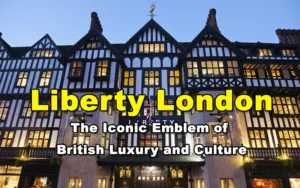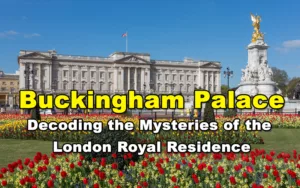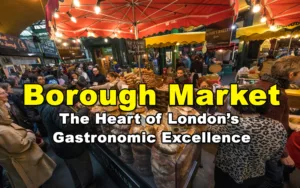Stretching majestically through London’s bustling centre in the City of Westminster, Regent Street is more than just a thoroughfare; it’s an emblem of the city’s illustrious legacy and its dynamic present. Widely acclaimed as a nexus of luxury and style, this iconic boulevard dazzles with its opulent architecture, curated array of upscale boutiques, and the palpable energy that emanates from its every corner.
Visitors from all corners of the globe, lured by its reputation, find themselves meandering through its expanse, each step echoing with the whispers of history and the vibrant hum of modern life.
Regent Street is more than just its modern shops and towering buildings. If you look closely, you’ll see stories from the past etched in every brick and stone. It’s seen the grandeur of royal parades, the shifts in culture, and the evolution of style and trade that define the street today.
In simpler terms, Regent Street is more than a shopping destination; it’s a journey through time. It embodies the essence of London, blending its storied past with the lively pulse of the present. This street showcases London’s knack for embracing change while cherishing its heritage, always looking ahead with hope and determination.
Historical Background of Regent Street
In the dawn of the 19th century, London found itself at the cusp of unprecedented growth and transformation. As the city’s influence expanded on the global stage, its urban landscape needed to mirror this newfound prominence. This sentiment gave rise to the conception of a magnificent avenue that would exemplify London’s burgeoning stature – and the responsibility of this monumental task fell upon the shoulders of John Nash. A luminary in the world of architecture, Nash was renowned for his forward-thinking designs and penchant for grandeur.
Tasked with crafting one of London’s future iconic landmarks, Nash didn’t merely focus on creating a street that was visually appealing. Instead, he anchored his design on a profound strategic vision. He envisioned a boulevard that would bridge the tranquil, green expanses of Regent’s Park with the energetic epicentre of the city. In doing so, Regent Street was conceptualized as more than just a roadway; it was to be a harmonious fusion of nature’s serenity and urban dynamism, a reflection of London’s multifaceted character.
As the wheel of time turned, Regent Street, like the city itself, witnessed a series of metamorphoses. The lavishness of the Victorian era, with its ornate designs and penchant for extravagance, left its mark on the street, as did the subtler, more minimalist tendencies of the subsequent decades.
Each era imprinted its ethos on Regent Street, moulding its façade, yet never undermining its foundational elegance. The challenges were many – the devastation of wars, the wear and tear necessitating renovations, and the cultural revolutions that changed the very fabric of society. Yet, through every trial and transformation, Regent Street emerged unyielding, echoing London’s tenacious spirit and its timeless knack for marrying tradition with innovation.
Architectural Highlights
Nestled in the heart of London, Regent Street stands as more than a mere avenue for commerce; it’s a living gallery of architectural masterpieces. The street’s skyline, punctuated by stately edifices, prominently showcases the intricate Beaux-Arts and Neo-Baroque architectural styles. These styles, renowned for their elaborate facades, sweeping arches, and meticulous detailing, infuse Regent Street with a sense of regal elegance that harks back to eras gone by.
Regent Street has a unique charm, and a big part of that is the Quadrant. With its gentle curve, it reminds many of the beautiful streets in Paris, adding a touch of European flair. But it’s not just about looks; the Quadrant smoothly connects Regent Street to the lively Piccadilly Circus. As you walk this bend, you’re surrounded by stunning buildings that showcase the brilliance of architect John Nash, who believed in designing cities that were both pretty and practical.
Regent Street is more than just its famous curve. It’s lined with landmark buildings that showcase London’s rich architectural history. Think about Hamleys, the renowned toy store. Beyond the toys and joy it brings, its age-old façade has watched countless children’s eyes light up over the years. And then you have Liberty, notable for its distinct Tudor design, which epitomizes British artistry. It’s not merely a shopping spot; it’s like stepping into a historical tale. Every nook and building on Regent Street speaks of its evolution, from its humble beginnings to the majestic street it is today.
Shopping and Retail
Amidst London’s bustling landscape, Regent Street emerges as a radiant beacon of luxury retail, casting its allure far and wide, drawing in aficionados of style from every corner of the world. As one walks its length, they are greeted by a procession of premier brands, a harmonious blend of time-honoured fashion institutions and cutting-edge designers pushing the boundaries of style.
This avenue of opulence offers a cornucopia of retail delights. Whether it’s the intricate craftsmanship of bespoke tailoring, the shimmer of finely crafted jewellery, or the trailblazing designs of haute couture, Regent Street emerges as a haven for those with a discerning eye and a penchant for the finest things in life.
The avenue’s allure is further magnified by the presence of flagship stores, each a monumental testament to the brand it represents. These stores, often ensconced in buildings steeped in history, offer more than just products; they provide an immersive experience.
Stepping into one is akin to entering a world where the brand’s narrative unfolds, from its rich heritage to its contemporary innovations. The architecture of these establishments, with their grandeur and meticulous design, ensures they are not merely points of purchase but iconic landmarks, drawing in not just those with shopping bags, but also those with cameras, capturing their splendour.
However, Regent Street’s significance transcends its luxurious offerings. It stands as a trendsetter, a barometer of what’s en vogue in the ever-evolving world of fashion and luxury. Historically, this street has been the chosen ground for brands to unveil their pioneering collections and novel retail strategies.
They choose Regent Street, knowing that the reception here, from its sophisticated clientele, often sets the pace for the broader London market. In a city renowned for its style, Regent Street remains the yardstick, the gold standard, where today’s trends forecast tomorrow’s mainstream.
Events and Celebrations in Regent Street
Smack dab in the heart of London, Regent Street stretches out, ready for the city’s numerous celebrations. Among the highlights is the lighting of the Regent Street Christmas lights. What began in the 1950s has grown grander with each year. The moment those lights sparkle to life, the street turns into a glowing fairy tale setting, radiating the essence of Christmas. It’s a magnet for people, pulling in both Londoners and visitors, all gathering to soak up the festive atmosphere.
But the fun on Regent Street isn’t just for the winter months. When summer rolls around, the street changes its vibe with the Summer Streets Festival. The cars make way for music, live shows, and the delicious smells of outdoor food stalls. It becomes a walker’s paradise, a place where everyone, whether they’re friends, families, or just passers-by, can enjoy the sunny vibes and celebrate together.
Fashion, an integral aspect of Regent Street’s identity, also finds its moment in the spotlight. Throughout the year, the boulevard plays host to an array of fashion-centric events. Renowned designers and emerging talents alike choose this iconic setting to unveil their latest creations, drawing in style enthusiasts eager to get a first glimpse of the season’s trends.
But it’s not just fashion and festivals. Parades, a vibrant expression of London’s diverse culture, often meander their way down Regent Street. Celebrating everything from national holidays to cultural festivals, these parades add a burst of color and energy to the street, further cementing its reputation as a hub of activity.
Given its prime location and historical significance, Regent Street is invariably at the forefront of London’s major celebrations. Be it welcoming the New Year with pomp and splendour, marking significant national events, or being the chosen venue for international festivities, Regent Street is more than just a street; it’s where London comes together, a place where memories are made, and the city’s collective spirit of celebration finds its most expressive outlet.
Cultural Significance of Regent Street
Tucked away in the vast urban landscape of London, Regent Street shines as a landmark, deeply rooted in the cultural heart of the city and beyond. Its majestic buildings, each holding a story, and the lively energy of the crowd make it a favourite in pop culture. Filmmakers and writers, captivated by its charm, often spotlight this street in their works. From romantic moments under its twinkling Christmas lights to thrilling chase sequences weaving through its paths, Regent Street has carved a special place in cinematic history, captivating audiences worldwide.
The world of literature, too, hasn’t remained untouched by Regent Street’s charm. Many a writer, from celebrated novelists to budding poets, has ambled along its stretch, drawing muse from its harmonious blend of the old-world charm and contemporary pulse. In their works, Regent Street often transcends its physicality to become a living, breathing entity. It’s portrayed not merely as a setting but as a protagonist, a silent observer, or even a muse, capturing the hopes, dreams, and myriad emotions of the characters that inhabit its narrative.
Yet, beyond the silver screen and the pages of books, Regent Street’s cultural significance is rooted in its very essence. It stands as a living testament to London’s dynamic ethos, a place where the past and the present coalesce seamlessly.
The street is emblematic of London’s commitment to progress while holding its history in reverence. It represents the city’s bustling retail heartbeat, its thriving arts scene, and its unwavering spirit of innovation. For many, a journey down Regent Street is akin to a voyage through the annals of London’s cultural evolution.
Every corner whispers tales of bygone eras, every store showcases the latest in global trends, and every step taken is a dance between history and modernity. In essence, Regent Street is not just a landmark; it’s a cultural institution, epitomizing London’s timeless allure and its ever-evolving narrative.
Modern Developments to Regent Street
In the ever-changing landscape of urban development, iconic landmarks like Regent Street face the intricate challenge of maintaining their historic essence while aligning with modern-day expectations and needs. In recent decades, Regent Street has risen to this challenge with commendable finesse, undergoing thoughtful renovations that balance reverence for its storied past with a keen eye on the future.
One of the standout features of these renovations has been the painstaking restoration of its architectural facades. Each brick, arch, and ornament has been treated with meticulous care, ensuring that the street retains its historic elegance. Simultaneously, the interiors of many of its establishments have been revamped, marrying vintage aesthetics with modern amenities and design principles, resulting in spaces that exude old-world charm while offering contemporary comforts.
In today’s world, where walking-friendly spaces are becoming more important, Regent Street has stepped up to make pedestrians a priority. Every now and then, parts of this busy street turn into walk-only areas, giving visitors a relaxed and deeper experience. This change doesn’t just improve shopping and eating out; it also builds a community feeling. With cars out of the picture, Regent Street becomes a lively spot for city-goers, where both locals and tourists can wander, chat, or just enjoy the vibe.
Peering into the horizon, the roadmap for Regent Street’s future is painted with ambitious plans that seamlessly intertwine its rich heritage with the demands of the 21st century. Proposals are in place to expand its pedestrian-friendly realms, championing a more sustainable and eco-conscious approach. Additionally, there’s a palpable buzz around the integration of state-of-the-art technology, aimed at enhancing visitor experiences while paying homage to the street’s architectural magnificence.
In essence, as Regent Street charts its course into the future, it does so with a clear vision: to stand as a testament to London’s ability to honour its history while ardently embracing progress. This iconic street, with its blend of the timeless and the contemporary, is poised to remain a cherished gem in London’s crown, reflecting the city’s adaptability and its unwavering spirit of evolution.
Summing Up Regent Street
Regent Street isn’t just another road in London’s vast cityscape. It’s like an open book, sharing stories of a city that’s stood at the heart of history, creativity, and business for ages. Looking at its magnificent buildings and feeling its lively buzz, you quickly realize Regent Street is a mini-version of London – where past memories smoothly mix with today’s energy.
Every stone, each shop, and all events on this famed street hold the dreams and hard work of many, including visionaries like John Nash. Regent Street isn’t just a location; it’s a celebration of London’s unbeatable spirit, its deep-rooted culture, and its constant push to be better and bolder.
For those unacquainted with its allure, Regent Street extends a warm, open invitation. It beckons you to traverse its length, to feel the heartbeat of a city that has been the muse for poets, the canvas for artists, and the inspiration for dreamers.
As you walk its storied pathways, you’re not merely exploring a street; you’re stepping into a narrative that spans centuries. It’s a journey that promises to captivate, offering a profound insight into the soul of a city that has, time and again, proven its resilience, its passion, and its unmatched ability to evolve while cherishing its roots. In essence, to know Regent Street is to know London, in all its splendid complexity.
“I may earn commissions as an affiliate from sponsored links within this post”







